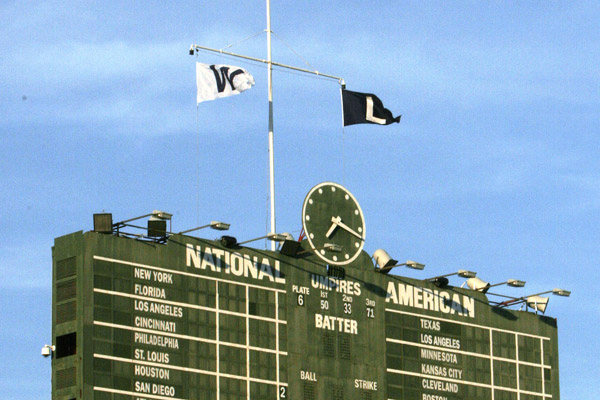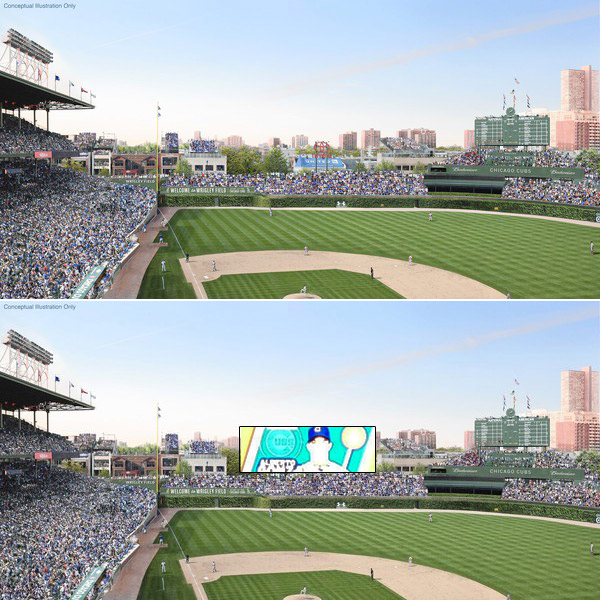
Phil Velasquez/Chicago Tribune
As if to highlight the work that needs to be done on Wrigley, Tom Ricketts gave a press conference, announcing the Cubs' preliminary deal with the city, in one of the stadium's less romantic camera angles:
.png)
The conference itself didn't reveal any more details than have already been reported: the Cubs still want a 6,000-square-foot Jumbotron (though the Trib is reporting 5,000 sq. ft.) and a second sign; they want to move the exterior walls on Waveland and Sheffield (which would minimize the extent that the Jumbotron and new ad sign would block the view of the rooftops, because of how geometry works); Ricketts hasn't talked to the rooftop owners about the possibility of a lawsuit "recently"; they plan on building a hotel and "open plaza." Ricketts estimated that the proposed work will take five offseasons.
For their part, the rooftop owners released a pretty chill statement: they "echo the sentiment of all parties involved for our desire that the Cubs play baseball in a modernized Wrigley Field as soon as possible" but "reserve the right to use any and all means necessary to enforce the remaining 11 years of our 20-year contract."
Oh, one bit of news: if they get the deal, Ricketts says they'll win the World Series. City Hall is encouraged to get that part in writing, along with any relevant clauses about crippling, season-destroying NLCS errors.
They did sweeten the pot for the city a bit: $1 million for the School Street Playlot, another $3.75 million for "community infrastructure and amenities." And they've still got barriers to smooth over with the city. Not just the strong-rubber-stamp City Council, or the threatened lawsuit from the rooftop owners, but the Landmarks Commission, which could get interesting.
The Landmarks Commission, after it denied landmark protection to Bertrand Goldberg's Prentice Hospital, was dismissed as a rubber stamp of its own, a tool of the mayor. But Prentice wasn't already landmarked; it wasn't in use; while obviously technically and structurally innovative, it's wasn't universally recognized as an aesthetic masterpiece in the way that Goldberg's nearby work is; and it's just not that well known a building. Even if you think the Commission was merely doing the bidding of the powers that be, there just wasn't enough leverage on the other side.
Wrigley Field, on the other hand, is world-famous. It's protected by specific language. The "generally uninterrupted sweep" of the bleachers that's part of the ordinance is one of the most recognizable vistas in professional sports. (If, like me, your only exposure to professional baseball was through WGN and TBS, consider your memories of Wrigley versus Atlanta-Fulton County Stadium.) Even the Cubs players—whose salaries are paid by whatever revenue the team can bring in—had mixed feelings about a Jumbotron when surveyed by Paul Sullivan.
What would it look like? Here's a rough before-and-after mockup, assuming that it's three times the size of the center-field scoreboard.

Neither the size nor the proportions are guaranteed, and given the tight geometry of the stadium and rooftops, both those are sure to be issues.
So for all the talk of a deal—and it's significant that City Hall and Tom Tunney are on board—there's still a long way to go. There are negotiations to be done with the rooftop owners, and any ideas are going to have to pass muster with the Landmarks Commission, which will be under significantly more pressure than it's been in years. On the other hand, the Cubs' backwards momentum, most recently "five wild pitches, two passed balls, a hit batter and balk" (a rare walk-off balk, no less), might actually give them a tiny edge off the field.



